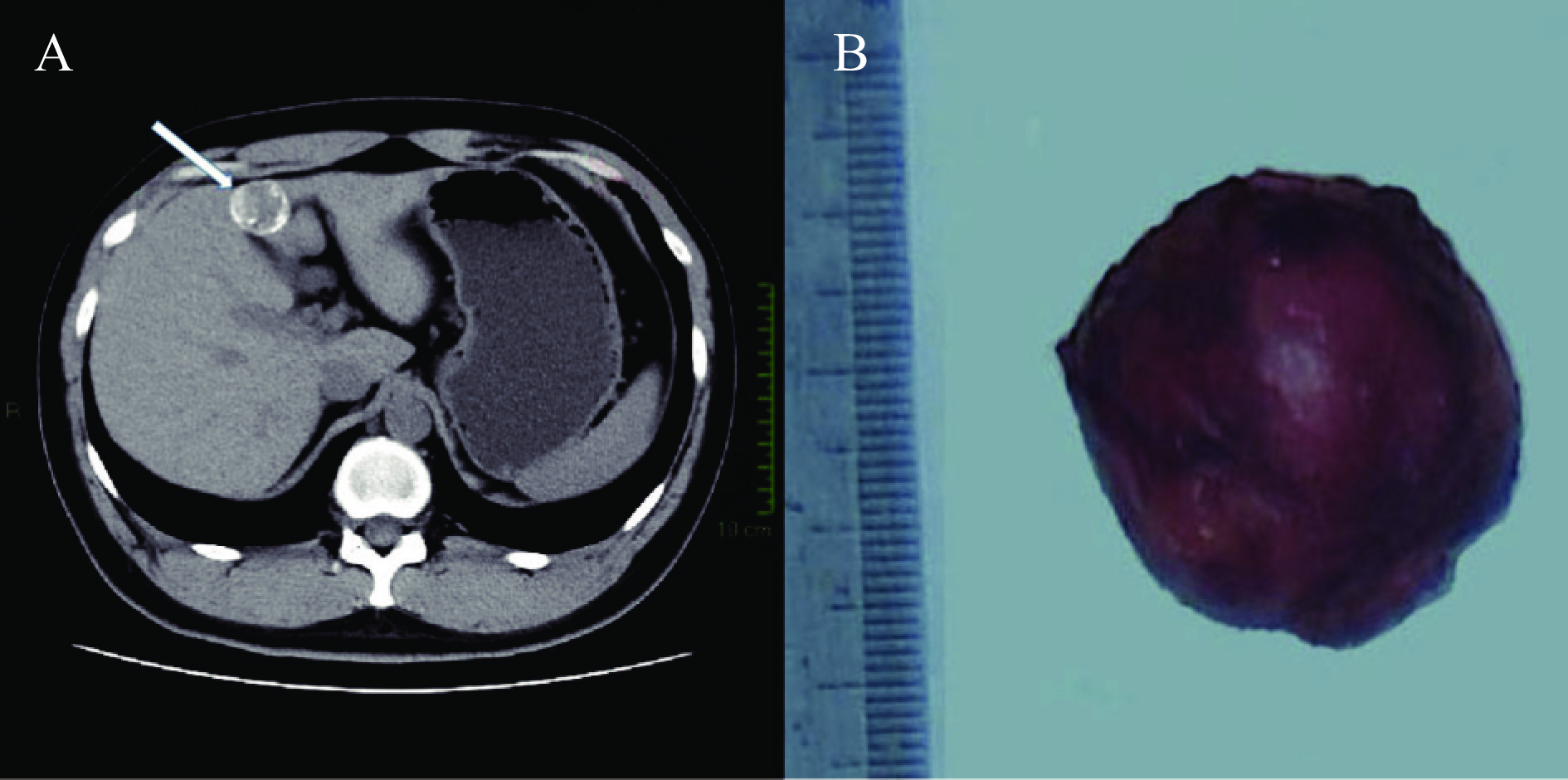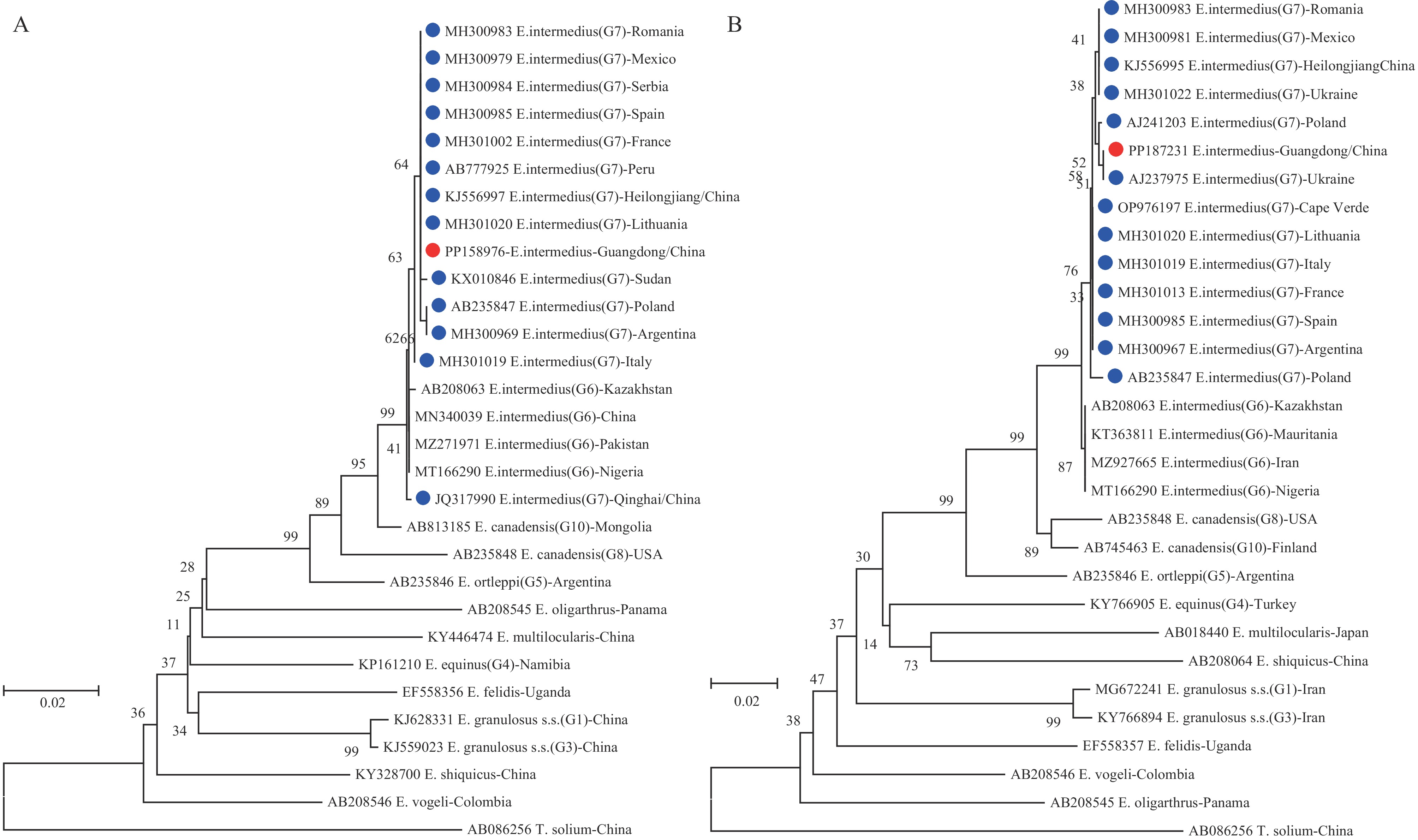-
Echinococcosis, a zoonotic disease resulting from infection by Echinococcus larvae, has been a persistent health threat. This disease transmits to humans through the ingestion of parasitic eggs. By 2022, China reported echinococcosis in nine epidemic regions encompassing 290,926 villages across 370 affected counties (including cities, districts, and banners). A total of 26,773 cases were recorded, predominantly in the provincial-level administrative divisions (PLADs) of Sichuan, Qinghai, and Xizang (1). Advances in molecular technology have facilitated the differentiation of Echinococcus species into several genotypes, specifically G1–G10 and the so-called lion genotype. With the exception of the G2 and G9 genotypes, all others have been verified (2). Currently, the predominant genotype in China is G1, complemented by minor occurrences of G3 and G6 genotypes (3–6). The G7 genotype, however, has been infrequently reported (7).
In December 2023, a case of hepatic cystic echinococcosis was reported in Zhuhai City, Guangdong Province. To confirm the diagnosis and trace the source of infection, we conducted epidemiological investigations, case searches, polymerase chain reaction (PCR) testing, genotyping, and examination of tapeworm eggs in canine feces. Findings revealed that the individual had no travel or residency history in areas known for such infections. Genotyping identified the Echinococcus granulosus as belonging to the G7 genotype, a genotype seldom observed in China (7). Preventive measures recommended include health education in the affected area, banning unauthorized livestock slaughtering, stricter quarantine and management of imported livestock, and enhanced monitoring and pathogen testing of cases.
-
A 27-year-old male presented at Zhuhai People’s Hospital on November 26, 2023, with black stool. The following day, he underwent hemostatic endoscopic surgery for a duodenal ulcer. Before discharge, the patient noted a lump in his upper left abdomen but exhibited no clinical symptoms and requested further evaluation. A computer tomography (CT) scan of the upper abdomen performed on November 30 revealed a space-occupying lesion in the left lobe of the liver. He was readmitted on December 11, and a laparoscopic resection of the mass was successfully performed on December 14, completely removing the mass without any complications.
Since 2016, the individual primarily lived in Nanxiong City, Zhuhai City, and Guangzhou City in Guangdong Province, as well as Wuhan City in Hubei Province, with the longest duration spent in Nanxiong City. Throughout this time, he made short visits to Henan and Jiangsu provinces. He asserted that he neither traveled to nor resided in areas known for epidemics, nor did he purchase leather or frozen meat products from such regions online. Although he is fond of cats and dogs, he has not kept them at home. While residing in Wuhan and Zhuhai, he frequently encountered stray cats and occasionally stray dogs. In his native Nanxiong, where most villagers own dogs, he had more frequent interactions with dogs. However, his family is not involved in livestock slaughter or the fur processing industry.
To better elucidate the potential infection origins, we investigated livestock sources and slaughtering practices in Nanxiong City. In Nanxiong, pork is the predominant meat consumed, and pigs must be slaughtered at officially designated sites. Given the prohibition on swine imports from other PLADs into Guangdong, all pigs in Nanxiong are sourced locally. Unlike pigs, cattle in Nanxiong are not predominantly from large-scale farms but are rather raised by individual farmers. Annually, over 2,000 cattle — including water buffalo, yellow cattle, and Simmental cattle — are processed in local slaughterhouses. These cattle are sourced primarily from PLADs outside Guangdong, with Liaoning, Xinjiang, and Inner Mongolia being major suppliers. In contrast, local sheep consumption is minimal, with most sheep sourced from Xinfeng County, Jiangxi Province.
According to the Diagnostic Criteria for Echinococcosis (WS 257-2006), we conducted a case search via the China Information System for Disease Control and Prevention (CISDCP). Since the first reported case of imported E. granulosus in 2006, a total of 149 echinococcosis cases have been recorded through December 2023. These include 28 confirmed, 4 clinically diagnosed, and 117 suspected cases. Notably, none of these cases were confirmed through nucleic acid diagnosis or molecular typing. Additionally, 53 canine fecal samples collected from Zhuhai and Nanxiong were examined for Echinococcus eggs using an automatic fecal analysis system; no eggs were detected in these samples.
The initial medical evaluations play a critical role in the diagnostic process for this case. Routine blood tests showed a monocyte count of 0.61×109/L, marginally above the normal range of 0.1×109‒0.6×109/L, with all other parameters falling within normal limits. CT imaging of the upper abdomen revealed a normal liver morphology, but identified a circular, mixed-density nodular shadow near the capsule in the left inner lobe, measuring approximately 23 mm in diameter. This lesion displayed multiple internal calcifications, particularly around its clearly defined edges (Figure 1A). Histopathological examination confirmed the presence of a grayish-yellow tumor with a dark red, oval contour measuring 2.8 cm × tumor was encapsulated, with most of the capsule remaining intact (Figure 1B).
 Figure 1.
Figure 1.Abdominal CT and Cysts of Cystic Echinococcus Case in Zhuhai City, Guangdong Province, 2023. (A) A circular image (arrows) in the left inner lobe of the liver, displaying a diameter of approximately 23 mm; (B) the complete cysts that were surgically removed.
Abbreviation: CT=computer tomography.To confirm the diagnosis, pathological tissue samples were collected from which nucleic acids were extracted. The cox1 and nad1 genes were amplified to produce PCR fragments of 874 bp and 529 bp, respectively. These products were then sequenced, yielding effective DNA sequences of 791 bp and 479 bp. BLAST sequence alignment showed that these sequences exhibited 100% nucleotide homology with Echinococcus granulosus sensu lato genotype G7 isolate 92 mitochondrion (MH301020.1) and Echinococcus candidasis mitochondrial NADH1 gene strain G7 (AJ237975.1). Both sequences were deposited in GenBank under the accession numbers PP158976.1 and PP187231.1.
To determine the genotype of the Echinococcus granulosus strain identified in this study (2023-ZH-EG-1), we compared the cox1 and nad1 gene sequences with 28 corresponding sequences from GenBank. We employed these sequences to construct phylogenetic trees as displayed in Figure 2. These sequences encompassed a range of genotypes within the Echinococcus genus, specifically G1, G3–G8, G10, and the Lion strain. Analysis of the phylogenetic trees revealed that the gene sequences of E. granulosus from our study clustered with the reference G7 genotype initially, and subsequently formed a broader cluster with the G6 genotype. This clustering pattern distinctly separates it from other genotypes. Based on these observations, we concluded that the E. granulosus strain in this study belongs to the G7 genotype.
-
It is necessary to promote the prevention knowledge of echinococcosis among residents in the area where the case occurred. Echinococcosis monitoring should be carried out in medical institutions in Shaoguan City, and local government departments should further strengthen animal slaughter management and animal disease quarantine.
-
This study presents the first reported instance of hepatic echinococcosis in an individual with no travel or residency history in an endemic area. Additionally, this is the first laboratory-confirmed case of its genotype in Guangdong. Consequently, it is critical to determine the time and location of infection, identify the source, and, most importantly, understand the transmission pattern.
Following infection, individuals typically remain asymptomatic for extended periods, attributable to the slow growth of cysts, particularly in the liver where growth rates vary from 1 mm to 5 mm in diameter annually (8). The cyst examined in this instance measured approximately 25 mm and exhibited signs of partial calcification, suggesting that the infection may have occurred between 2 to 3 years ago, or possibly earlier. Epidemiological investigations revealed that during this period, the patient resided primarily in Wuhan, Zhuhai, and Nanxiong cities. The likelihood of encountering the infection source in Wuhan and Zhuhai was notably low. Dogs are recognized as a critical reservoir host for echinococcosis, and in Nanxiong, the patient had increased contact with dogs, thus raising the probability of infection. Consequently, it appears more plausible that the infection was contracted in Nanxiong.
Livestock serve as significant intermediate hosts for Echinococcus granulosus. Recent surveys indicate that while the infection rate of Echinococcus in livestock within endemic regions of China has considerably declined, sheep and cattle remain the predominant intermediate hosts. For genotype G7, domestic pigs are the most common intermediate hosts (9), though instances in goats and wildlife have also been reported (3). In Nanxiong, a substantial number of cattle and a smaller number of sheep are annually imported from endemic areas. This movement of livestock poses a risk of introducing pathogens into Guangdong, potentially leading to localized transmission cycles.
Echinococcus species have a global distribution, found in Asia, Europe, North America, Oceania, and some African countries. The primary endemic areas in Northwest China include Xinjiang, Xizang, Qinghai, Gansu, Ningxia, Sichuan, and Inner Mongolia PLADs (4). Currently, of the 9 recognized genotypes of Echinococcus effective in human infection, genotypes G1, G6, and G7 are predominant, comprising 88.4%, 7.34%, and 3.7% of human infections respectively (5). Although the G7 genotype is less commonly observed in humans and animals globally compared to G1, in certain countries like Poland and Austria, it accounts for 100% (30/30) and 92.0% (23/25) of human hydatid cyst cases, respectively (6). Hence, the pathogenicity of E. granulosus genotypes appears to be influenced by geographic factors. The G7 genotype, also known as the “pig strain”, primarily uses pigs as its intermediate hosts, though cattle, goats, sheep, and wild bears can also fulfill this role (6). The broad distribution of the G7 genotype indicates its adaptability and suggests the potential establishment of a cycle involving this genotype in Guangdong.
In 2011, Jin et al. identified the G7 genotype of Echinococcus intermedius in goats from Qinghai Province. By 2014, Zhang et al. detected this genotype in four out of ten human liver cysts in Heilongjiang Province, marking the first documented instance of human infection with the G7 genotype of Echinococcus granulosus in China (6). The current study reveals that cases of echinococcosis of unknown origin in Zhuhai City, Guangdong Province, are attributable to the G7 genotype of E. granulosus. This represents the first report of such infections in Guangdong Province, and the third instance in China. Similar to isolated cases, such as the G7 genotype in Heilongjiang Province (6) and the G5 genotype in Guangxi and Guizhou PLADs (10), the recent case also emerged in a region not typically endemic for echinococcosis. These findings emphasize the urgent need for enhanced echinococcosis prevention and control measures in regions not traditionally affected by the disease, particularly through stringent quarantine and management of potential intermediate hosts such as pigs, cattle, and sheep.
Based on the findings, we propose two potential transmission patterns for echinococcosis in Guangdong. The first is an input pattern, wherein pathogens are introduced into the area through the importation of livestock. Dogs contract the infection by consuming the organs of these infected animals, subsequently transmitting the disease to humans through contact. The second pattern is local, characterized by a consistent, albeit low-level, cycle of echinococcosis among local fauna, with infrequent human transmission. It is imperative to enhance quarantine measures to fully elucidate these transmission dynamics.
-
No conflicts of interest.
-
The physicians at Zhuhai First People’s Hospital for their assistance with medical examinations and for providing CT images.
HTML
| Citation: |




 Download:
Download:





